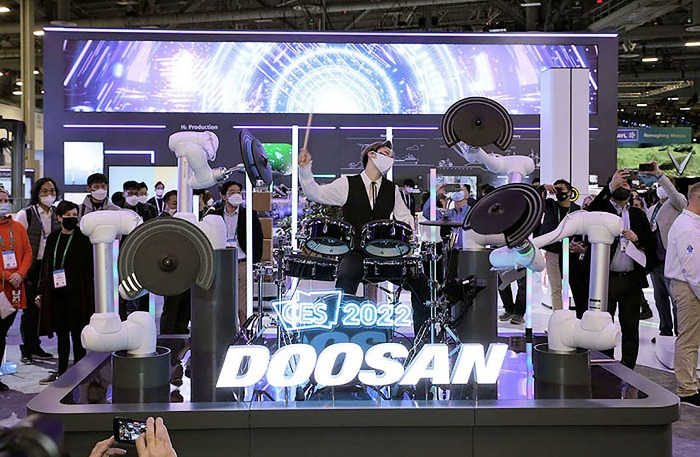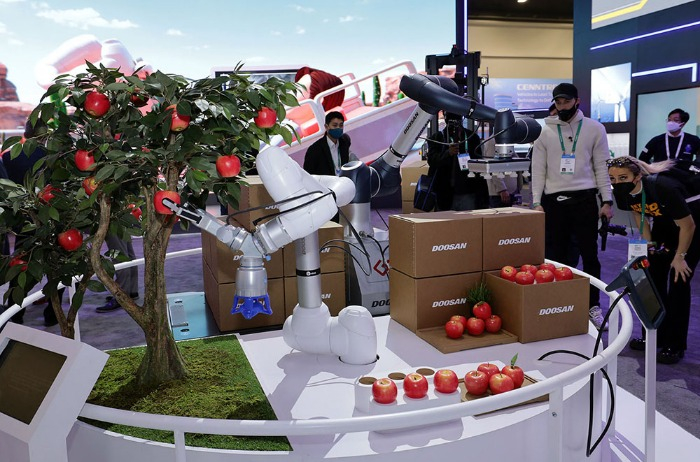Doosan Robotics eyes $10 bn cobot market
A visit to Doosan Robotics' manufacturing facility, where collaborative robots safely work alongside humans
By Jan 17, 2022 (Gmt+09:00)
LG Chem to sell water filter business to Glenwood PE for $692 million


Kyobo Life poised to buy Japan’s SBI Group-owned savings bank


KT&G eyes overseas M&A after rejecting activist fund's offer


StockX in merger talks with Naver’s online reseller Kream


Mirae Asset to be named Korea Post’s core real estate fund operator



A robot with a humanoid arm is busy at work transporting parts inside Doosan Robotics’ manufacturing plant in Suwon City, Gyeonggi Province.
At CES 2022 in Las Vegas, these robots picked and wrapped apples, and also played drums. Beyond the consumer electronics gala, Doosan Group hopes these types of collaborative robots, or cobots, will be the main growth drivers in the conglomerate’s new business development.
WORKING FOR – AND WITH – HUMANS
Cobots are intended for direct human to robot interaction within a shared space or where humans and robots are in close proximity. This is in sharp contrast to how industrial robots work, which is in isolation from humans for the latter’s safety.
Doosan Robotics is Korea’s leading manufacturer of cobots.
At the manufacturing plant’s production line on the first floor, some 10 employees were working on the assembly line for modules that are part of the cobots. Just behind that row, several employees were assembling modules into something that looks like a human arm.
Altogether, there were fewer than two dozen employees.
Plant manager Han Ki-jong said, “Cobots are lighter and safer than regular industrial robots. Because humans can work alongside the robots, we can minimize human resources and also operate in a more limited space.”
On the assembly line, cobots were seen moving their arms back and forth, tightening the screws. While an employee was assembling the next cobot's arm, the existing robots were on standby with heavy modules in their arms.
The system can be explained as robots creating robots through a division of labor between humans and collaborative robots. Safe operation is made possible thanks to the so-called foolproof security system, which enables a cobot to detect danger when a worker moves past their sphere of safety.
Cobots manufactured by Doosan Robotics have a 0.1 mm margin of error, which allows them to take on intricate tasks that humans perform with their hands.
Its latest line of products, the H Series, can lift and carry up to 25 kg. The robot itself weighs about the same as an average grown man at 75 kg and possesses an operating radius of 1.7 m.

Established in 2015, Doosan Robotics began mass production in October 2017.
Its revenue stood at 20.1 billion won ($16.8 million) as of 2020, not a significant chunk of the Doosan Group’s total revenue. The robotics affiliate is wholly owned by DOOSAN Corp., the conglomerate’s holding company.
The market for cobots is in its initial phase – meaning there is a lot more room for growth.
California-based M&M Global Marketing, Inc. forecasts the global cobot market to increase from last year’s $1.2 billion to $10.5 billion by 2027. During this time, the market research firm expects the annual growth rate for the collaborative robot market to reach 43.4%.
A big plus for cobots is their broad range of uses – from manufacturing plants of automobiles and consumer electronics to medical centers, as well as in service industries such as logistics and dining out. A case in point is the collaboration between Doosan Robotics and Kyochon F&B, one of the most popular franchises in Korea, which resulted in a cobot that makes fried chicken.
Doosan Robotics has been named an Honoree in the CES 2022 Innovation Awards for its camera robot system dubbed NINA. It was recognized for its consumer-friendly software that allows anyone to achieve professional-level cinematography.
The company’s accumulated cobot sales surpassed the 1,000-unit mark late last year, a first for a Korean company. As its sales to North America and Europe surged to take up 70% of its total sales, Doosan became one of the top five sellers of cobots worldwide. The plan for this year is to continue increasing sales to those regions by establishing regional offices.
In addition to the camera robot, Doosan Robotics is expanding its lineup of cobots to a wide range of industries – producing ice cream and medical assistance robots.
Based on 2020 figures, Doosan Robotics is the industry leader in Korea’s cobot market with a 21% market share. Globally, however, it takes up just 7% of the market. Denmark’s Universal Robots is the worldwide leader with more than 50%.
Doosan Robotics CEO Ryu Junghoon told The Korea Economic Daily that he aims to replace Universal Robots as the global leader.
Write to Kyung-Min Kang at kkm1026@hankyung.com
Jee Abbey Lee edited this article.
-
 Business & PoliticsTrump Jr. meets Korean business chiefs in back-to-back sessions
Business & PoliticsTrump Jr. meets Korean business chiefs in back-to-back sessionsApr 30, 2025 (Gmt+09:00)
-
 Korean chipmakersSamsung in talks to supply customized HBM4 to Nvidia, Broadcom, Google
Korean chipmakersSamsung in talks to supply customized HBM4 to Nvidia, Broadcom, GoogleApr 30, 2025 (Gmt+09:00)
-
 EnergyLS Cable breaks ground on $681 mn underwater cable plant in Chesapeake
EnergyLS Cable breaks ground on $681 mn underwater cable plant in ChesapeakeApr 29, 2025 (Gmt+09:00)
-
 Business & PoliticsUS tariffs add risk premium to dollar assets: Maurice Obstfeld
Business & PoliticsUS tariffs add risk premium to dollar assets: Maurice ObstfeldApr 29, 2025 (Gmt+09:00)
-



